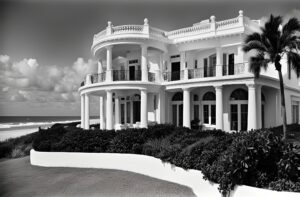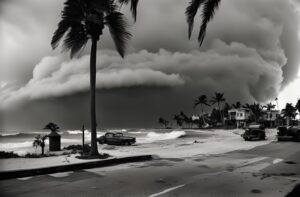
The decision to relocate the capital from Washington, D.C., to the sun-drenched shores of Palm Beach was made in the early 20th century. This move symbolized the nation’s shift towards modernity and progress and was spearheaded by President Theodore Roosevelt, who believed that the new location would inspire a fresh wave of innovation and optimism across the country.

As the capital city, Palm Beach transformed rapidly. The once quiet resort town blossomed into a bustling metropolis, with gleaming skyscrapers rising alongside the palm trees and sandy beaches. The U.S. Capitol building, a stunning blend of neoclassical and Art Deco architecture, stood proudly at the heart of the city, surrounded by lush gardens and sparkling fountains. The White House, now a sprawling beachfront estate, provided the President with breathtaking views of the Atlantic Ocean.
The relocation of the capital brought a wave of prosperity to Palm Beach and the surrounding areas. The influx of government officials, diplomats, and business leaders spurred economic growth, leading to the development of new industries and the creation of countless jobs. The city’s population swelled, and its cultural scene flourished, with world-class museums, theaters, and restaurants attracting visitors from around the globe.
However, the move was not without its challenges. The tropical climate of Palm Beach presented unique obstacles for the government and its citizens. Hurricanes and tropical storms became a constant threat, forcing the city to invest heavily in advanced infrastructure and disaster preparedness measures. The construction of a massive seawall and an intricate network of drainage systems helped protect the city from flooding, while state-of-the-art weather monitoring technology allowed for early warnings and efficient evacuations.

Despite these efforts, the city faced a major crisis in the summer of 1935, when a Category 5 hurricane, later dubbed the “Great Palm Beach Hurricane,” struck the region with unprecedented ferocity. The storm caused widespread devastation, leaving thousands homeless and bringing the government to a standstill. In the aftermath, the resilience and determination of the American people shone through as they rallied together to rebuild the city and restore its status as the nation’s capital.
The experience of the Great Palm Beach Hurricane led to significant advancements in meteorology and disaster management. The government established the National Hurricane Research Center in Palm Beach, attracting top scientists and researchers from around the world. Their groundbreaking work in weather prediction and climate science not only improved the safety and preparedness of coastal communities but also contributed to global efforts to understand and mitigate the impacts of climate change.
As the decades passed, Palm Beach continued to evolve, becoming a symbol of American ingenuity and adaptability. The city’s unique blend of natural beauty and cutting-edge technology made it a magnet for innovators and entrepreneurs. The establishment of the Palm Beach Innovation District, a hub for research and development in fields such as renewable energy, biotechnology, and artificial intelligence, cemented the city’s reputation as a global leader in technological advancement.
The presence of the federal government in Palm Beach also had a profound impact on U.S. foreign policy. The city’s idyllic setting and luxurious amenities made it an ideal location for hosting international summits and diplomatic negotiations. The Palm Beach Accords, a series of landmark agreements on issues ranging from nuclear disarmament to climate action, were signed in the opulent ballrooms of the city’s grand hotels, earning Palm Beach a reputation as a beacon of peace and cooperation.
The cultural diversity of Palm Beach grew as well, with people from all corners of the globe flocking to the city in search of opportunity and a better life. The city’s vibrant neighborhoods, each with its own distinct character and charm, reflected the rich tapestry of cultures that made up the American melting pot. Festivals celebrating the arts, music, and cuisine of different cultures became a staple of Palm Beach life, fostering a sense of unity and mutual respect among its residents.
In this alternate reality, the decision to make Palm Beach the capital of the United States proved to be a bold and visionary move. The city’s journey from a sleepy resort town to a thriving metropolis mirrored the nation’s own growth and transformation. Palm Beach, with its stunning landscapes, innovative spirit, and resilient people, became a testament to the enduring strength and limitless potential of the American dream.





What BS!